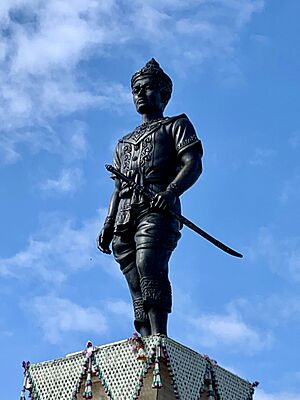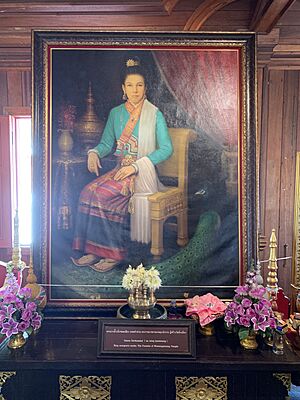Mangrai facts for kids
Quick facts for kids Mangraiᨾᩢ᩠ᨦᩁᩣ᩠ᨿ มังราย |
|
|---|---|

King Mangrai Monument in Chiang Rai
|
|
| King of Lanna | |
| Reign | 1292–1311 |
| Predecessor | Himself as King of Ngoenyang |
| Successor | Chaisongkhram |
| King of Ngoenyang | |
| Reign | 1261–1292 |
| Predecessor | Lao Meng |
| Successor | Himself as King of Lanna |
| Born | 1239 Chiang Saen, Ngoenyang |
| Died | 1311 (aged 73) Chiang Mai, Lanna |
| House | Mangrai Dynasty |
| Father | Lao Meng |
| Mother | Ua Ming Chom Mueang |
| Mangrai | |
|---|---|

"Phaya Mengrai" in Tai Tham script
|
|
| Northern Thai name | |
| Northern Thai | ᨻᩕ᩠ᨿᩣᨾᩢ᩠ᨦᩁᩣ᩠ᨿ |
Mangrai (Northern Thai: ᨾᩢ᩠ᨦᩁᩣ᩠ᨿ; Thai: มังราย; 1238–1311) was a very important king in Southeast Asian history. He was the 25th king of Ngoenyang and later became the first king of the powerful Lanna Kingdom. King Mangrai is famous for creating a new capital city, Chiang Mai, which became the heart of the Lanna Kingdom from 1296 to 1558.
Contents
The Early Life of King Mangrai
King Mangrai was born on October 23, 1238. His birthplace was Ngoen Yang, which is now known as Amphoe Chiang Saen in Thailand. This city was located right by the Mekong River.
His father was Lao Meng, who was the local ruler of Ngoen Yang. His mother was Ua Ming Chom Mueang. She was a princess from a Tai Lue city called Chiang Rung. Today, Chiang Rung is known as Jinghong in Xishuangbanna, China.
Becoming a King and Expanding His Realm
In 1259, Mangrai took over from his father. He became the first independent king of the many small Tai city-states in what is now northern Lanna and northern Laos. He saw that these Tai states were not united and faced dangers.
So, King Mangrai quickly started to make his kingdom bigger. He conquered areas like Muang Lai, Chiang Kham, and Chiang Khong. He also made strong alliances, or friendships, with other nearby states.
In 1262, he founded a new city called Chiang Rai. This city, located in the Kok River basin, became his new capital. Around this time, he also worked in the area of Fang, in the Upper Kok Valley.
Forming Important Alliances
In 1287, King Mangrai made peace between two other powerful kings. These were King Ngam Muang of Phayao and King Ram Khamhaeng of Sukhothai. The three kings then formed a very strong friendship pact. This alliance helped bring stability to the region.
Conquering Haripunchai
While he was still in the Fang area, King Mangrai met merchants from the Mon kingdom of Haripunchai. This kingdom, now known as Lamphun, was said to be very wealthy. Mangrai decided he wanted to conquer it, even though his advisors told him not to.
It was believed that Haripunchai was too strong to be taken by force. So, King Mangrai sent a clever merchant named Ai Fa. Ai Fa acted as a secret agent, or "mole," to gain the trust of Haripunchai's King Yi Ba. Over time, Ai Fa became the Chief Minister and slowly weakened the king's power.
By 1291, the people of Haripunchai were unhappy. King Mangrai then defeated the Mon kingdom and added Haripunchai to his growing kingdom. King Yi Ba, the last king of Hariphunchai, had to escape south to Lampang.
The Chiang Mai Era
After his victory over Hariphunchai, King Mangrai decided to move his capital again. In 1294, he founded a city called Wiang Kum Kam on the eastern bank of the Ping River. However, this new site often suffered from floods.
So, a new location was chosen a few kilometers to the northwest. This spot was at the base of Doi Suthep mountain. It was also the site of an older fortified town belonging to the Lua people.
Building the New Capital: Chiang Mai
Construction of Chiang Mai began in 1296. The name "Chiang Mai" literally means "New City." Since its founding, Chiang Mai has mostly remained the capital of the northern provinces.
A few years later, King Yi Ba's son, King Boek of Lampang, attacked Chiang Mai. He came with a very large army. King Mangrai and his second son, Prince Khram, led the defense against the Lampang army.
Prince Khram bravely fought King Boek in a one-on-one battle while riding elephants. This fight happened at Khua Mung, a village near Lamphun. King Boek tried to escape through the Doi Khun Tan mountain range, but he was caught and executed. King Mangrai's troops then took over the city of Lampang. King Yi Ba had to flee even further south, this time to Phitsanulok.
King Mangrai's Later Years and Legacy
King Mangrai's oldest son became impatient and tried to take the throne. However, his attempt failed, and he was executed. After this, Mangrai's second son, Khun Kham, was chosen to be the next king.
King Mangrai died in 1311 in Chiang Mai. It is said that he was struck by lightning during a thunderstorm while he was in the city's market. He was 73 years old.
Succession and Stability
After King Mangrai's death, there was a period of confusion. Six different kings ruled in the next eleven years. This could have been very bad for the kingdom. However, the kingdoms to the north and south, like Sukhothai, were also having their own problems.
The Lanna Kingdom finally became stable again in 1328. This was when Mangrai's grandson, Kham Fu, became king. Kham Fu brought back the strong leadership that the kingdom had enjoyed during King Mangrai's time.


